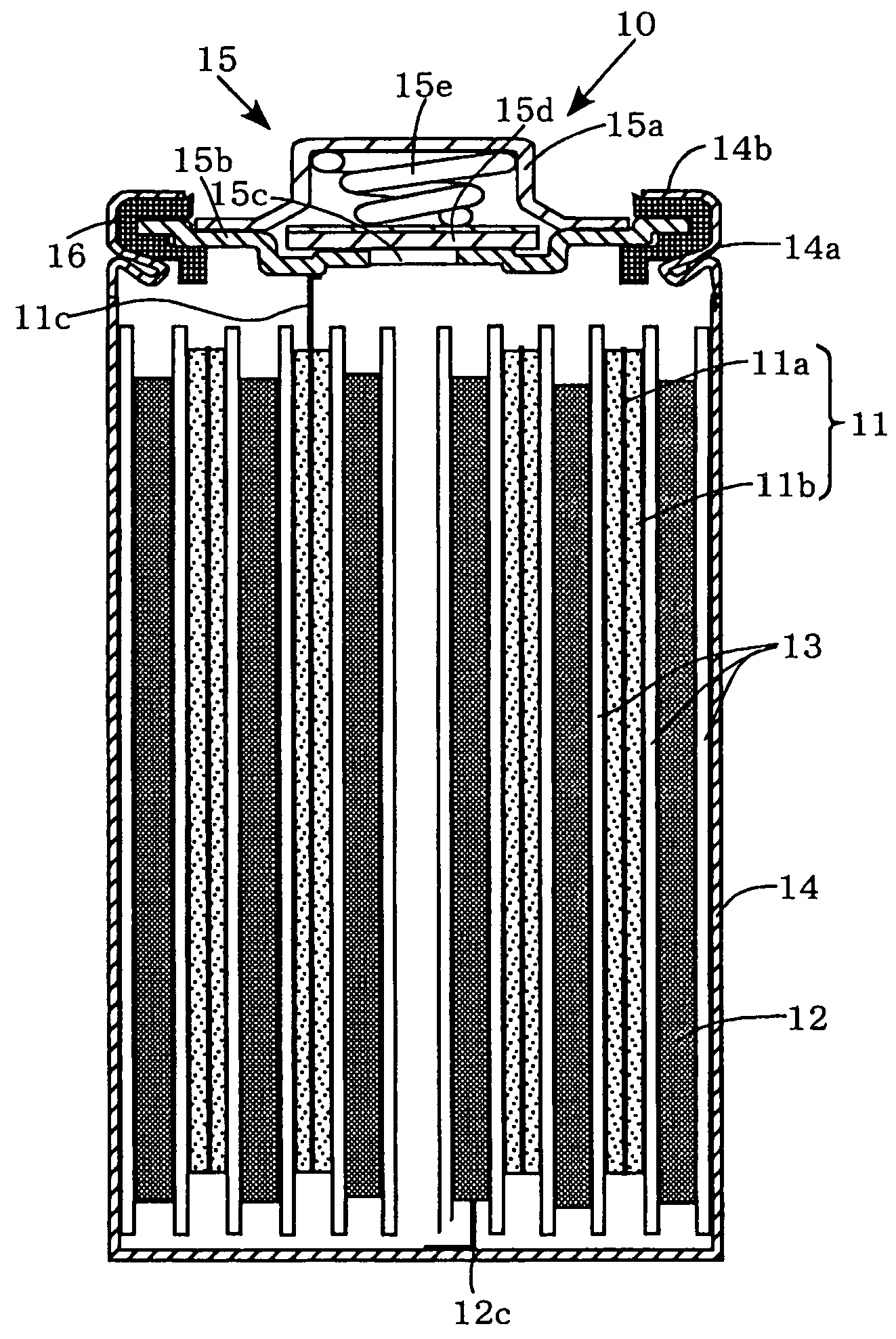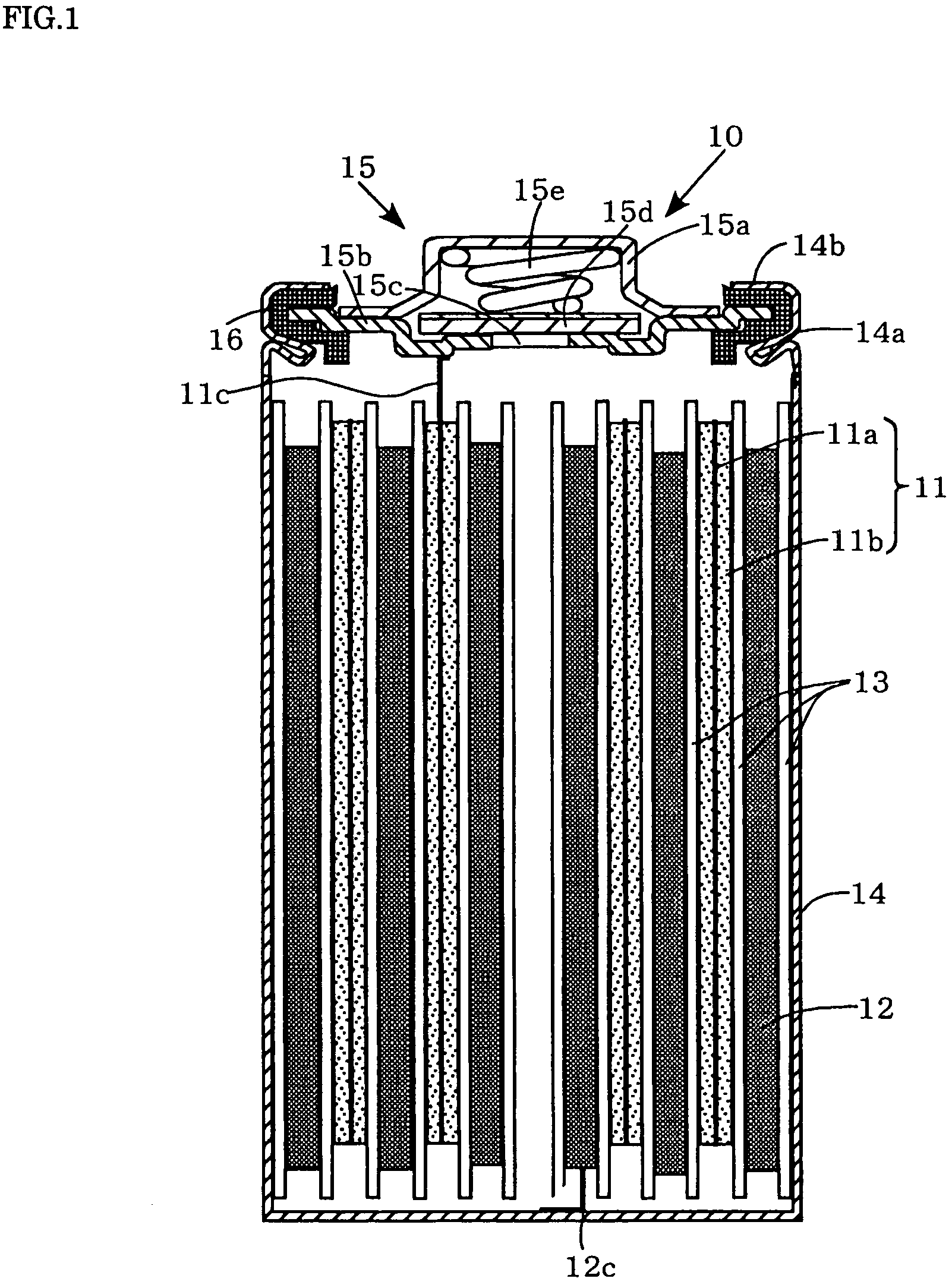Nonaqueous electrolyte secondary battery
a secondary battery and electrolyte technology, applied in the direction of positive electrodes, electrochemical generators, cell components, etc., can solve the problems of poor safety and large overvoltage inferior to lithium cobalt oxide, etc., to achieve sufficient output/input characteristics, reduce output characteristics, and increase the thickness of the positive electrode
- Summary
- Abstract
- Description
- Claims
- Application Information
AI Technical Summary
Benefits of technology
Problems solved by technology
Method used
Image
Examples
example 1
(1) EXAMPLE 1
[0047]Each of the positive electrodes 11 (a to g) and the negative electrode 12 are laminated with a separator 13, formed of a polypropylene microporous film, interposed therebetween, and wound spirally to form spiral electrode groups. Then these spiral electrode groups are inserted into a cylindrical metallic outer can 14 that has a swaged portion 14a formed by swaging around the perimeter of an upper portion thereof. Then, the negative electrode collector tab 12c extending from the negative electrode 12 is welded to the inner bottom of the metallic outer can 14. On the other hand, the positive electrode collector tab 11c extending from the positive electrode 11 is welded to the bottom of a positive electrode lid 15b of a sealing unit 15. Disposed around the perimeter of the sealing unit 15 is a ring-shaped insulation gasket 16. Disposed above the positive electrode lid 15b is a cap-shaped positive electrode terminal 15a. Disposed inside this cap-shaped positive electr...
example 2
(2) EXAMPLE 2
[0056]The positive electrode active material θ in which Zr of 0.5 mole % is added to a lithium transition metal oxide represented by Li1.07(Ni0.4Co0.3Mn0.3)0.93O2 having an average particle diameter of 12.4 μm is prepared. Moreover, the positive electrode active material ι in which Nb of 0.5 mole % is added to a lithium transition metal oxide represented by Li1.07(Ni0.4Co0.3Mn0.3)0.93O2 and having an average particle diameter of 12.5 μm is prepared.
[0057]Then, the positive electrode active materials θ and ι thus prepared, carbon powder serving as a conductive agent, and polyvinylidene fluoride (PVDF) serving as a binder are added to N-methyl-2-pyrrolidone (NMP) so that their mass ratio is 92:5:3, and mixed to make positive electrode slurry. Using the positive electrode slurry thus made, the position electrode h (one using the positive electrode active material θ) and the positive electrode i (one using the positive electrode active material ι) and the positive electrode...
PUM
| Property | Measurement | Unit |
|---|---|---|
| average particle diameter | aaaaa | aaaaa |
| average particle diameter | aaaaa | aaaaa |
| average particle diameter | aaaaa | aaaaa |
Abstract
Description
Claims
Application Information
 Login to View More
Login to View More - R&D
- Intellectual Property
- Life Sciences
- Materials
- Tech Scout
- Unparalleled Data Quality
- Higher Quality Content
- 60% Fewer Hallucinations
Browse by: Latest US Patents, China's latest patents, Technical Efficacy Thesaurus, Application Domain, Technology Topic, Popular Technical Reports.
© 2025 PatSnap. All rights reserved.Legal|Privacy policy|Modern Slavery Act Transparency Statement|Sitemap|About US| Contact US: help@patsnap.com


